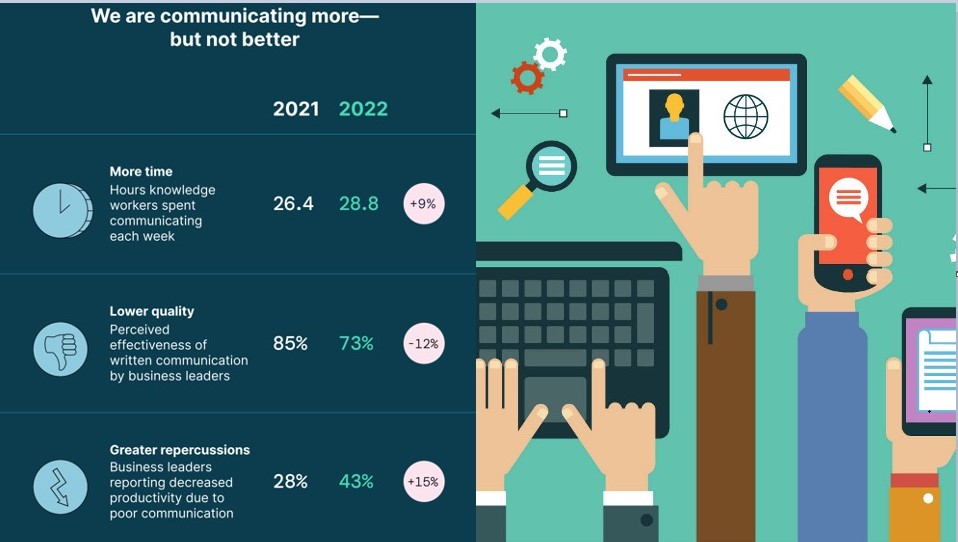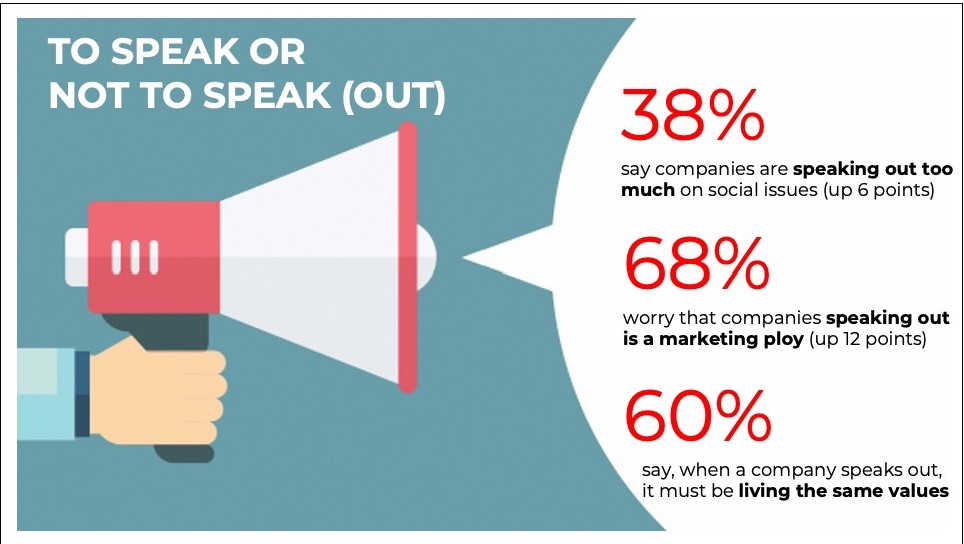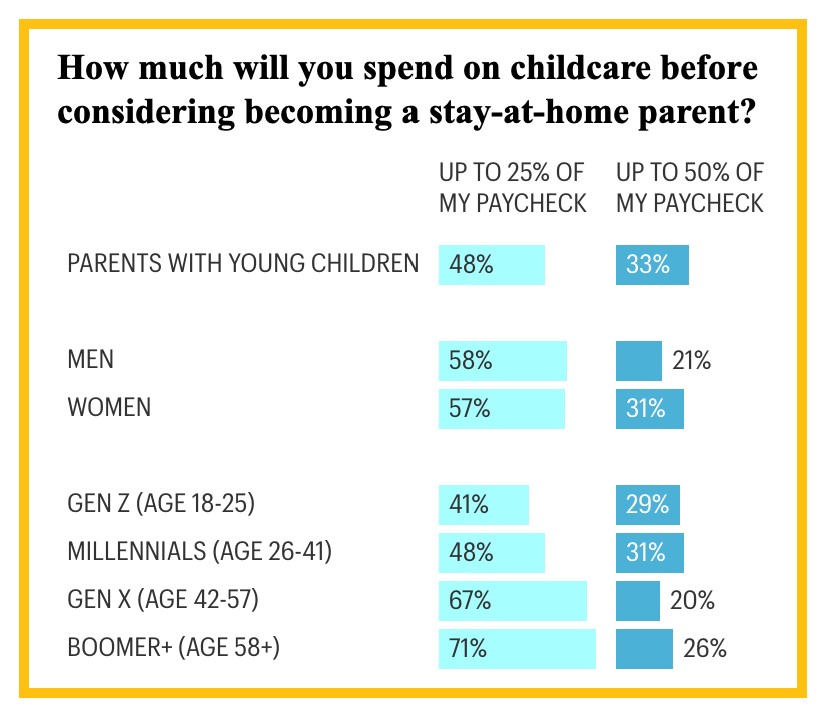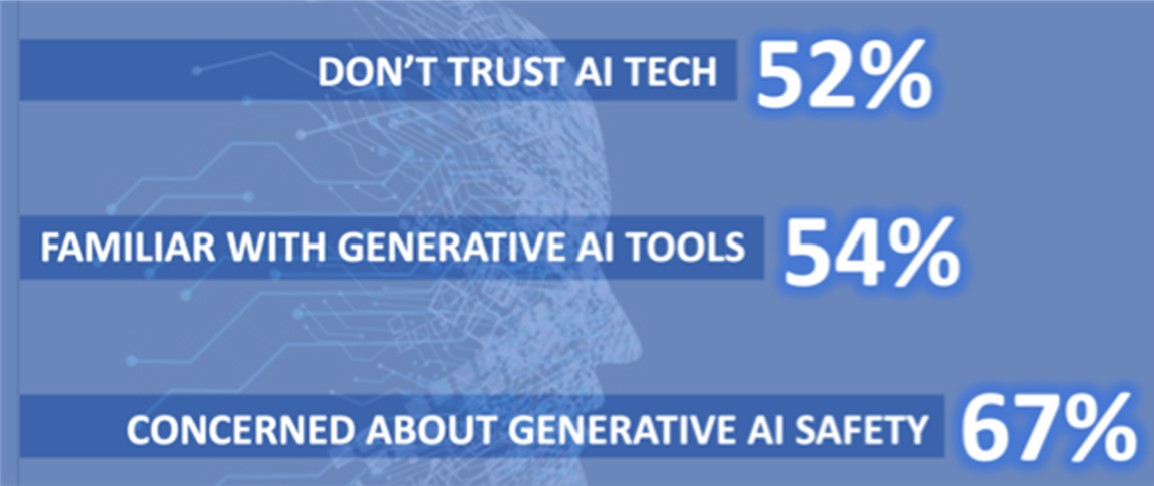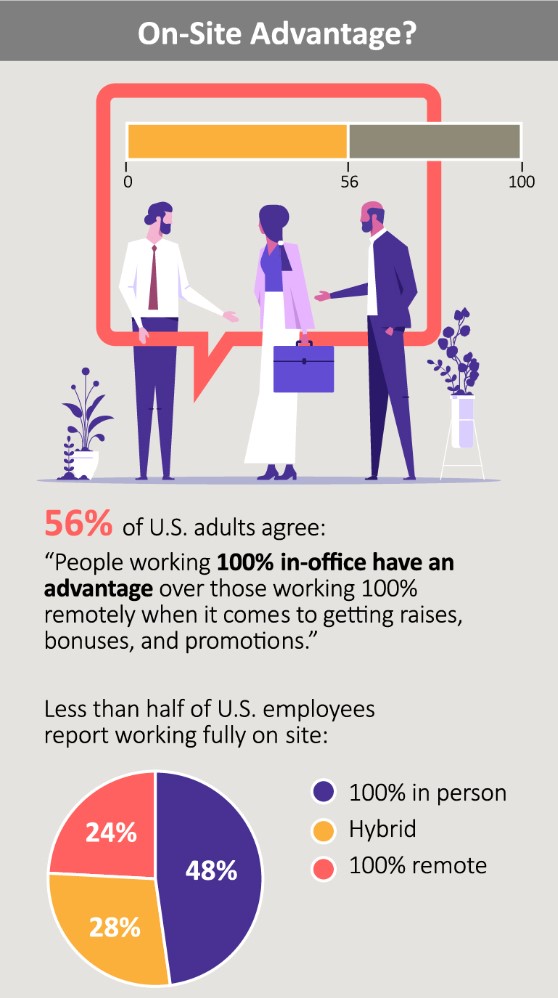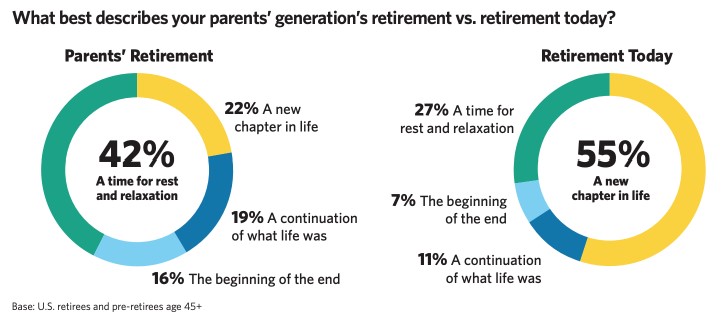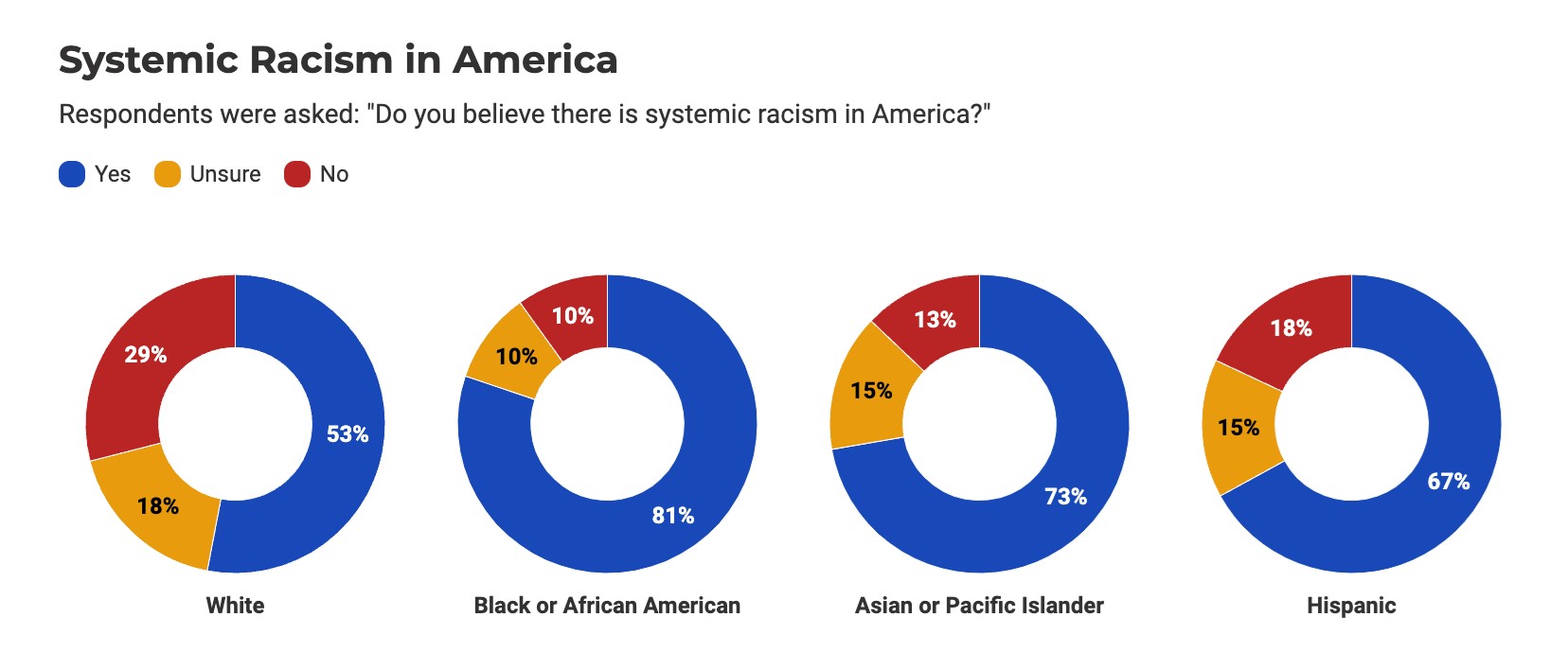By: Ray Day
CONTACT:
We wanted to share our latest consumer and business insights, based on research from Stagwell. Among the highlights of our weekly consumer sentiment tracking (fielded Feb. 17-19):
WORRIES ABOUT ECONOMY MODERATE:
Today, 87% of Americans are concerned about the economy and inflation – down 3 points from last week and up from 82% in December.
- 80% worry about U.S. crime rates (down 4 points)
- 80% about a potential U.S. recession (down 2 points)
- 73% about political divisiveness (down 2 points)
- 72% about the War on Ukraine (no change)
- 68% about affording their living expenses (down 7 points)
- 55% about a new COVID-19 variant (no change)
- 46% about losing their jobs (down 1 point)
WORK FROM HOME BUT INTERVIEW IRL
A recent Harris Poll found that 41% of Americans are likely to consider pursuing a new job within the next six months. In our latest survey with American Staffing Association, remote employees like working from home, yet they want to meet their new boss face-to-face first.
- 70% of job seekers say they want to interview in person for a new job rather than a video (17%) or phone call (9%).
- 67% say they feel the need to modify their usual appearances in some way before a job interview.
- Before an interview, more Black Americans feel the need to shave their facial hair (33% versus 22% for White Americans), while both Hispanic (19%) and Black Americans (17%) also feel the need to cover tattoos (White 10%) and remove facial piercings (18% for Hispanic, 14% for Black and 9% for White).
COMMUNICATING MORE BUT NOT BETTER:
Today’s hybrid workplace is a whirlwind of communication – with employees spending more than 70% of their work week communicating on various channels. That’s up from last year – yet poor communications also is causing a steep decline in productivity and effectiveness, according to our “State of Business Communication: The Path to Productivity, Performance, and Profit” report with Grammarly.
- Employees are spending 9% more time communicating – 28.8 hours a week – compared with last year.
- Leaders report a 12% drop in the effectiveness of written communication over the same period and a 15% decline in productivity.
- This is causing employee stress – with workers reporting a 7% increase in stress due to poor communications compared with a year ago.
- 84% of business leaders are feeling the downsides of poor communication, with lower productivity, missed deadlines and increased costs ranking as the top three.
- Most leaders (60%) and nearly half (45%) of workers say personal connections have suffered in the hybrid workplace.
- 68% of leaders say they lost at least $10,000 or more in business in the past year due to poor communications. One in five also say poor communications eroded their brand credibility or reputation.
DOCTORS DON’T HAVE TIME FOR YOUR DATA
As patient portals become more common and telehealth data pours in from apps and wearables, doctors have more data than time, according to our survey with ZS.
- 71% of primary care physicians say they have more data than they can handle.
- The patient data problem is compounded by the fact that 57% of doctors report that technology flaws are a barrier to having better-connected health care.
- 86% of primary care physicians say that a lack of reimbursement for connecting health care is a hurdle.
ICYMI:
In case you missed it, check out some of the thought-leadership and happenings around Stagwell making news:
- February Harvard CAPS-Harris Poll: Perception of economy is improving but only a third believe it is on the right track
- All Generations Find Telehealth Beneficial, New CVS Health Data Shows
- Almost Two-Thirds of U.S. Doctors, Nurses Feel Burnt Out at Work
- Streamer ads performed well during the Super Bowl
As always, if helpful, we would be happy to provide more info on any of these data or insights. Please do not hesitate to reach out.
Thank you.
Related
Articles
In the News, Press Releases, Thought Leadership
Jun 10, 2025
Stagwell (STGW) Chairman and CEO Mark Penn to Discuss the Irreplaceable Power of Human Creativity on the Main Stage of Cannes Lions

Events, In the News, Press Releases, Talent & Awards
Jun 05, 2025
Code and Theory Named ANA B2B Agency of the Year After Transforming the World’s Leading Brands

In the News, Press Releases, Talent & Awards
May 19, 2025
Stagwell (STGW) Appoints Connie Chan as Chief Growth Officer for Asia Pacific

Newsletter
Sign Up
By: Ray Day
CONTACT:
We wanted to share our latest consumer and business insights, based on research from Stagwell. Among the highlights of our weekly consumer sentiment tracking (fielded Feb. 10-12):
WORRIES ABOUT ECONOMY JUMP:
Today, 90% of Americans are concerned about the economy and inflation – up 5 points from last week and up sharply from 82% in December.
- 84% worry about U.S. crime rates (up 6 points)
- 82% about a potential U.S. recession (up 2 points)
- 75% about affording their living expenses (up 5 points)
- 75% about political divisiveness (up 3 points)
- 72% about the War on Ukraine (up 2 points)
- 55% about a new COVID-19 variant (down 2 points)
- 47% about losing their jobs (up 2 points)
WHEN SHOULD COMPANIES SPEAK OUT?:
Following the State of the Union (SOTU) address, we surveyed Americans to pinpoint their views on the buy-American theme as well as to update our past research on companies “speaking out” on social issues. We found strong views on both.
“Made in America”
- Nearly three-quarters (73%) of Americans say they often seek American-made products and brands when shopping (up 1 point from July 2022), especially true among those who watched some or all of the SOTU.
- Regarding intentionally purchasing American-made products and brands, 71% report doing so a little bit or a lot.
- 53% have shopped for an American-made product in the last month.
- 76% of Americans agree that there should be more American-made products and brands available in the U.S.
- 76% agree that brands need to make more products in the U.S. (up 1 point from July 2022).
- 56% would be willing to pay more for a product if they knew it was American made.
- However, 45% believe that American-made products already are too expensive.
“Speaking Out in America”
- A third of Americans (38%) think that American companies are speaking out too much on social issues (up 6 points from July 2022).
- 37% believe companies are speaking out the right amount (down 3 points from July 2022), while 25% believe they aren’t speaking out enough (down 3 points).
- 68% of Americans think that, when companies voice their opinion on a social issue, it’s a marketing ploy (up 12 points from July 2022).
- When companies are speaking out on social issues, 71% of Americans agree that a company’s history on social issues is important.
- 60% agree that when a company speaks out on social issues, it must be supported by living their internal company values.
- More Americans believe that there is generally more risk (59%) to a CEO speaking out on social issues (up 5 points from April 2022) than reward (41%).
- Democrats (55%) are more likely to believe there is more reward in a CEO speaking out than Republicans (33%).
- Americans also believe that CEOs expressing their own political views is bad for the company (47%, up 5 points from April 2022), more so than good.
TRAVEL TRENDS FOR THE NEXT DECADE:
During the next three years, nearly 2 billion people will travel at least once a year – making the travel and hospitality industry continually attractive. Yet what does the future hold? Stagwell’s Northstar partnered with travel technology company Amadeus on new research defining four new types of travelers – in a report titled Traveler Tribes 2033 – who will emerge in the next decade along with suggestions on what brands need to do to create relevant travel experiences for them.
- Excited Experientialists:
- 44% are without children and have a mid- to high-income job with flexible working options, which enables them to readily explore the world. They are more likely than other travelers to act on instinct, making them “anti-planners” and favoring less predictable and more exciting accommodation experiences. They also are open to technology like the use of artificial intelligence in the airport environment.
- Memory Makers:
- 44% are ages 42 and older and are habitual in their travel behaviors. They put people first and place less value on technology and sustainability, reassured by existing methods. Despite their skepticism about technology, they are excited about virtual reality and augmented reality preview tours before purchasing a trip.
- Travel Tech-fluencers:
- 48% of the group are under the age of 32, and their perspective is symbolized by how much technology they own. While many want to travel sustainably, they are more conscious about sustainability options around their method of travel, rather than where they’ll be staying.
- Pioneering Pathfinders:
- 82% are between the ages of 23 and 41. They like to plan but are not afraid of risk and are open to new experiences. This group is more willing than others to let sustainability influence their decisions. They will be very comfortable using all forms of alternative payment methods – whether cryptocurrency or within a virtual reality environment.
EMPLOYEES AND HR DISAGREE ON RACIAL EQUITY PROGRESS:
Our new State of Inequity report with Hue illuminates wide disparities along racial lines in workplace opportunity, compensation and experience in a post-pandemic labor market.
- More than 200,000 Black and Latina women have disappeared from the workforce since the pandemic’s beginning. Many have stopped looking for new jobs, making them invisible to unemployment statistics and ineligible for federal benefits.
- Most BIPOC employees report their employer has not instituted racial awareness training (82%) nor have they increased recruiting efforts toward racially diverse hiring (81%).
- A gap exists between HR and employees: 84% of BIPOC employees report their company has not addressed the mental/emotional impact of discrimination on its employees of color since June 2020. At the same time, 91% of HR professionals surveyed say the various diversity-related initiatives their companies have implemented are effective.
- One in four BIPOC women report not being paid fairly and in a comparable way to other colleagues at their level across their company.
- BIPOC women are twice as likely not to be paid fairly and in a comparable way to other colleagues across their company compared to white men.
- Two in Five BIPOC women reported feeling exhausted or burned out last year because of their workplace.
- BIPOC women are twice more likely to report they have felt fatigued related to racial tension or issues at work in the last six months compared to white men.
- More BIPOC women are not comfortable being fully themselves at work, twice as likely compared to white men.
- Even in the face of workplace hardships, BIPOC women are investing in themselves. Nearly twice as many BIPOC women (45%) report gaining new skills or education to become a more competitive job candidate compared to white Americans (27%).
ICYMI:
In case you missed it, check out some of the thought-leadership and happenings around Stagwell making news:
- Vast Majority of Americans Prefer In-Person Job Interviews vs. Virtual
- Exploring the future of money
- The high price of being single: ‘It’s all on one person’
- Americans With Trouble Sleeping Report Their Sleep Affects Their Relationships
As always, if helpful, we would be happy to provide more info on any of these data or insights. Please do not hesitate to reach out.
Thank you.
Related
Articles
In the News, Press Releases, Thought Leadership
Jun 10, 2025
Stagwell (STGW) Chairman and CEO Mark Penn to Discuss the Irreplaceable Power of Human Creativity on the Main Stage of Cannes Lions

Events, In the News, Press Releases, Talent & Awards
Jun 05, 2025
Code and Theory Named ANA B2B Agency of the Year After Transforming the World’s Leading Brands

In the News, Press Releases, Talent & Awards
May 19, 2025
Stagwell (STGW) Appoints Connie Chan as Chief Growth Officer for Asia Pacific

Newsletter
Sign Up
By: Ray Day
CONTACT:
We wanted to share our latest consumer and business insights, based on research from Stagwell. Among the highlights of our weekly consumer sentiment tracking (fielded Feb. 3-5):
WORRIES ABOUT JOB LOSSES JUMP:
Today, 85% of Americans are concerned about the economy and inflation – down 2 points from last week and up from 82% in December. Concerns about job losses, however, are on the rise.
- 80% worry about a potential U.S. recession (down 2 points)
- 78% about U.S. crime rates (down 3 points)
- 72% about political divisiveness (down 3 points)
- 70% about affording their living expenses (up 4 points)
- 70% about the War on Ukraine (up 1 point)
- 57% about a new COVID-19 variant (down 1 point)
- 45% about losing their jobs (up 3 points)
18% OF GEN Z WOULD BE HAPPY TO BE LAID OFF:
“Laid off and loving it” is the mood of a small but vocal group of employees caught in the job cuts roiling firms from Wall Street to Silicon Valley, according to our survey with Bloomberg.
- 18% of Gen Z and 15% of Millennial employees say they would be happy being laid off, more so than their older colleagues (Gen X: 8%, Boomers: 6%).
- Overall, one in 10 employees say they would feel thankful (9%), relieved (10%) and happy if laid off today (12%).
- Of those who experienced a layoff in the last year, 42% spent more time with friends and family, on their hobbies (28%) and their physical (26%) and mental health (29%).
- Most employed Americans (43%) say that, if they were laid off today, they would find another job within three months. Yet that changes across generations, with Boomers (28%) less likely to think so than Gen Z (43%), Millennials (48%) or Gen X (47%).
CHILDCARE SPENDING HAS ITS LIMITS:
How much are you willing to spend on childcare before it no longer makes sense to work? Most Americans say an average of $617 a month is fair. Yet, if childcare costs eat away a quarter of their paycheck or more, nearly half of parents with young children under the age of 5 would consider being a stay-at-home parent, according to our survey with Fortune.
- On average, U.S. families spend an average of 17.8% of their income on childcare.
- Younger workers are more willing than older Americans to pay more for childcare. And fathers are willing to spend about $100 more per month than mothers ($668 versus $568).
- More than a third of stay-at-home parents say they left their jobs to care for their children because of financial difficulties in affording childcare (19%) or limited childcare availability (17%).
- Among former and current stay-at-home parents, 36% say they felt forced into leaving the workforce to care for their children.
- 87% of Americans say they would continue working if childcare was more accessible – with high agreement across all age groups.
- 52% of stay-at-home parents with children under the age of 5 believe their careers have been negatively affected by that choice.
- 68% of both men and women believe mothers are penalized more in the workforce after staying home to care for children.
MORE TRUST CONCERNS ABOUT AI:
Americans rely on artificial intelligence to inform everyday consumer choices like movie recommendations and customer service inquiries, yet they draw the line when it comes to trusting AI for high-value applications, such as autonomous vehicles, accessing government benefits and healthcare. Our survey with MITRE also found:
- 48% of Americans believe AI is safe and secure.
- 78% are very or somewhat concerned that AI can be used for malicious intent.
- 82% of Americans and 91% of tech experts support government regulation.
- 70% of Americans and 92% of tech experts agree that there is a need for industry to invest more in AI assurance measures to protect the public.
- Three-quarters of Americans are concerned about deepfakes and other AI-generated content.
- Only 49% would be comfortable having an AI-based online chat for routine medical questions.
- Similarly, only 49% would be comfortable with the federal government using AI to assist benefits processing.
ESG INVESTOR INTEREST GROWS
Most investors are interested in ESG and want their advisors to show them the path forward, based on our survey with Nuveen.
- 75% of investors older than 21 with at least $100,000 in investable assets see their company ownership as a way to get businesses to address ESG-related risks and opportunities.
- 57% would be interested in shifting their portfolios to invest only in companies with net-zero emissions.
- 80% said that companies should be more transparent about ESG issues.
- 73% said they would be more likely to invest in businesses that are open about their plans for addressing those factors.
- Last year’s findings from the 2022 Milken Institute Harris Poll Listening Project found that 68% of executives said their company has as much as a quarter of their portfolio dedicated to ESG investments. Yet 32% said their companies lack ESG investments entirely.
ICYMI:
In case you missed it, check out some of the thought-leadership and happenings around Stagwell making news:
- ‘Funny,’ ‘light-hearted’ and ‘unique’ are top qualities the public wants in Super Bowl ads
- Building brand fandom at the Super Bowl
- Pandemic Pushes Planned Retirement Age by 3 Years
- Gen Z and Millennials Accept Online Creeping and Stalking as Part of Dating Culture
- Stagwell’s Instrument opens applications for 2023 pro bono program supporting black and systemically excluded communities
As always, if helpful, we would be happy to provide more info on any of these data or insights. Please do not hesitate to reach out.
Thank you.
Related
Articles
In the News, Press Releases, Thought Leadership
Jun 10, 2025
Stagwell (STGW) Chairman and CEO Mark Penn to Discuss the Irreplaceable Power of Human Creativity on the Main Stage of Cannes Lions

Events, In the News, Press Releases, Talent & Awards
Jun 05, 2025
Code and Theory Named ANA B2B Agency of the Year After Transforming the World’s Leading Brands

In the News, Press Releases, Talent & Awards
May 19, 2025
Stagwell (STGW) Appoints Connie Chan as Chief Growth Officer for Asia Pacific

Newsletter
Sign Up
By: Ray Day
CONTACT:
We wanted to share our latest consumer and business insights, based on research from Stagwell. Among the highlights of our weekly consumer sentiment tracking (fielded Jan. 27-29):
ECONOMIC WORRIES MIXED:
Today, 87% of Americans are concerned about the economy and inflation – up 1 point from last week and up from 82% in December.
- 82% worry about a potential U.S. recession (down 1 point)
- 81% about U.S. crime rates (up 1 point)
- 75% about political divisiveness (up 4 points)
- 69% about the War on Ukraine (up 1 point)
- 66% about affording their living expenses (down 5 points)
- 58% about a new COVID-19 variant (down 2 points)
- 42% about losing their jobs (down 7 points)
PARENTS WANT CHILDCARE SUPPORT AT WORK:
Parents increasingly feel unsupported in the workplace and expect more childcare support from employers and the government, based on our new Parent Confidence Report with KinderCare.
- 61% of working parents say there is a disconnect between the level of support they need and the benefits their employer provides.
- Childcare benefits are the second most important reason for parents staying at their current job – with 18% ranking them as the most crucial benefit – behind health insurance.
- More than half of working parents would stay at their current job if their employer provided childcare benefits, such as pre-tax benefits, emergency/backup childcare and on-site childcare.
- 70% of parents say childcare is at a crisis point in terms of accessibility and affordability.
- 66% believe the government should offer universal childcare to all children, from birth to kindergarten.
1 IN 10 LOOKING FOR NEW HOME, BUT WITH UNREALISTIC PRICE EXPECTATIONS:
For the fifth year in a row, most Americans (83%) say buying a home is a priority. Yet, in our latest survey with NerdWallet, high mortgage rates and a seller-friendly housing market prove to be obstacles – along with unrealistic home price expectations.
- 11% of Americans say they plan to buy a home in the next year.
- Prospective buyers hope to spend $269,200 on average. This is significantly lower than the typical home price of $379,100.
- 32% of Americans feel worse about their ability to purchase a home in 2023 than in 2022 (a 7-point increase from last year).
- The top reasons for the more negative outlook include a worsening economy (58%), higher mortgage rates (57%) and higher home prices (57%).
- 67% of Americans say a housing market crash is imminent in the next three years.
INVESTORS RETHINK RETIREMENT PLANS:
Turbulent market conditions and rampant inflation have forced investors to consider working after retirement, based on our survey with Nationwide.
- 69% of non-retired investors say post-retirement employment could lie ahead.
- 44% of these investors inclined to keep working say they’ll have to supplement their retirement savings or income out of necessity.
- 40% of non-retired investors plan to move to a different city or region after retiring, with the most common reasonings being lower cost of living (43%) and lower taxes (34%) – far ahead of being closer to family (22%).
- 49% of non-retired investors with a financial advisor are “very nervous” about spending down their retirement savings in today’s current market environment.
LACK OF TRUST OVERSHADOWS NEW AI TOOLS:
Businesses might need to slow their roll when it comes to adopting AI tools like ChatGPT and DALL-E2, according to our latest study with AdAge.
- 52% don’t trust AI tech.
- 54% are familiar with generative AI tools, and nearly a fifth have used one.
- 67% of Americans are concerned about the safety of generative AI technology.
- Only 29% said they have not used generative AI nor are they interested in doing so.
- Less than half (44%) say that it is easy to tell the difference between something created by AI and something created by a human.
- 58% think things created by generative AI tools are less impressive than things created by people.
ICYMI:
In case you missed it, check out some of the thought-leadership and happenings around Stagwell making news:
- Five Things to Know About ChatGPT
- Generative AI – how marketers should navigate consumer distrust
- Augmented reality. The bright future of women’s sports. What Gen Z wants from work. Stagwell’s National Research Group explores all of these topics in a new premium magazine, Boundless.
- 20 brands gaining popularity with Gen Z
- About three-quarters of people who plan to watch the Super Bowl said they’re excited for the ads
- Big Tech’s Free Ride Is Coming to an End
As always, if helpful, we would be happy to provide more info on any of these data or insights. Please do not hesitate to reach out.
Thank you.
Related
Articles
In the News, Press Releases, Thought Leadership
Jun 10, 2025
Stagwell (STGW) Chairman and CEO Mark Penn to Discuss the Irreplaceable Power of Human Creativity on the Main Stage of Cannes Lions

Events, In the News, Press Releases, Talent & Awards
Jun 05, 2025
Code and Theory Named ANA B2B Agency of the Year After Transforming the World’s Leading Brands

In the News, Press Releases, Talent & Awards
May 19, 2025
Stagwell (STGW) Appoints Connie Chan as Chief Growth Officer for Asia Pacific

Newsletter
Sign Up
By: Mark Penn
Originally Published on: Barron’s
About the author: Mark Penn is chairman and CEO of Stagwell, a technology-based global marketing services firm.
Technology’s Wild West era is coming to an end. For decades, American policy has been hands-off technology to let it grow and innovate. On the eve of the dawn of artificial intelligence and the metaverse, the bad taste consumers have of social media and its divisiveness suggests that more aggressive regulation is just around the corner.
The recent round of layoffs won’t do much to staunch consumers’ fears that technology is enabling the possibility of a surveillance state. Their concerns will accelerate movement on tech privacy, censorship, anticompetitiveness, and national security legislation in the U.S. and abroad in 2023.
Half of consumers in America fear that technology will undermine their personal freedoms over the next decade, and 70% worry that tech will give more power to big corporations. The younger generations are particularly suspicious of Big Tech. Elon Musk gave some journalists access to Twitter’s records after he bought the social company. The reports they produced, known as the Twitter Files, were a damning revelation that government officials were pulling the strings behind the curtain and that the tech companies were willingly obedient much of the time.
In a recent Harvard-Harris Poll, 70% of voters now support a national law to prevent corporate censorship. The saving grace for the tech industry may be that many Democrats believe that they have been benefiting from the censorship and will oppose such a law, not understanding that what goes around comes around. They will regret blocking this legislation when they believe that they are the ones being censored. I expect this to be a significant issue in the 2024 campaign.
If Big Brother colluding with Big Tech keeps consumers up at night, the thought of TikTok being a Trojan horse for Chinese influence and spying is catnip for Congress seeking to look tough on China. Before the close of the year, leaders let loose a rash of state-based restrictions on the use of the platform by government officials. The House banned its members and staff from downloading the app. TikTok has dozens of trends working against it: Democrats and Republicans are largely aligned on the need to curb China’s influence, the Biden administration’s negotiations with TikTok have stalled, and difficult news continues to leak that employees at TikTok have misused the app, most recently to spy on journalists. The company has said it doesn’t share data with Beijing, and it fired staff members that it said were involved in the spying incident.
Voters might be less invested in the diplomatic implications of a TikTok ban than your senator, but rest assured that if the government enacts an outright ban, consumers will be up in arms. TikTok is the fastest-growing social-media platform in the U.S. and has been taking ad-market share from its legacy competitors. Expect a compromise that allows TikTok to operate but puts restrictions on how it can use and distribute information.
Beyond the U.S., data-privacy regulations will mature in 2023, meaning that global businesses will face more severe restrictions as they do business across borders. Countries have moved to enact data-privacy regulations since the implementation of the European Union’s General Data Protection Regulation in 2018, and now more than 100 have rules in place, according to Forrester. By 2024, an estimated 75% of the world’s population will be covered under modern privacy regulations.
The good news is that businesses have tracked the “will they, won’t they” drama around Google’s plan to phase out user-tracking “cookies” long enough that they’ve found solutions to replace the tool—and have adjusted data-privacy standards. But a more bullish Federal Trade Commission, with a renewed focus on “harmful commercial surveillance and lax data security,” will mean that it isn’t time to rest on laurels. It’s unlikely that the U.S. will get a national standard like the proposed American Data Privacy Protection Act. But expect the FTC to oppose virtually any merger-and-acquisition activities in tech, even if the government loses its cases.
The impulse isn’t uniquely American. The EU is also taking anticompetitive action against tech giants with the adoption of the Digital Markets Act, which aims to curb the market power of dominant digital companies. We have yet to see alignment on comparable federal efforts in the U.S. but the FTC’s recent intervention into Microsoft’s Activision deal hints at more to come. The FTC will take on Google, too, for alleged anticompetitive practices, in September.
Big Tech remains a critical engine of economic opportunity and innovation. But once it began carrying news and political speech, the industry crossed a line that put it in politicians’ crosshairs. This eroded their traditionally loyal Republican free-market supporters as the Democrats were moving further to the left, taking on a more anti–big business flavor. The combination of these trends just may result in the first major year of regulation of the industry.
Related
Articles
In the News, Press Releases, Thought Leadership
Jun 10, 2025
Stagwell (STGW) Chairman and CEO Mark Penn to Discuss the Irreplaceable Power of Human Creativity on the Main Stage of Cannes Lions

Events, In the News, Press Releases, Talent & Awards
Jun 05, 2025
Code and Theory Named ANA B2B Agency of the Year After Transforming the World’s Leading Brands

In the News, Press Releases, Talent & Awards
May 19, 2025
Stagwell (STGW) Appoints Connie Chan as Chief Growth Officer for Asia Pacific

Newsletter
Sign Up
By: Ray Day
CONTACT:
We wanted to share our latest consumer and business insights, based on research from The Harris Poll, a Stagwell agency.
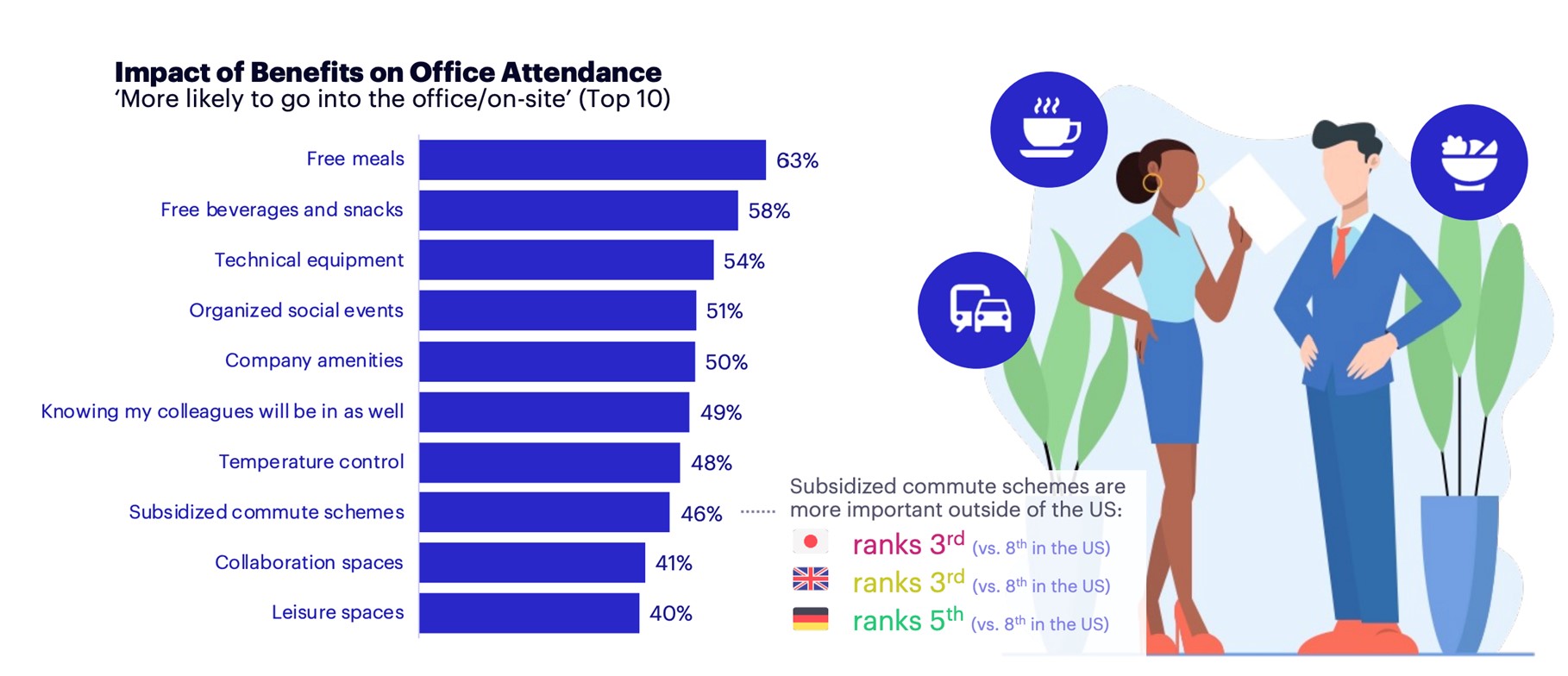
ECONOMIC WORRIES MIXED:
Today, 86% of Americans are concerned about the economy and inflation – down 2 points from last week and up from 82% in December.
- 83% worry about a potential U.S. recession (up 1 point)
- 80% about U.S. crime rates (no change)
- 71% about political divisiveness (down 1 point)
- 71% about affording their living expenses (down 3 points)
- 68% about the War on Ukraine (up 3 points)
- 60% about a new COVID-19 variant (up 1 point)
HALF OF GEN Z SEARCH THE WEB VERSUS CALLING A DOCTOR:
More Americans know their astrology sign (66%) and credit score (58%) than their blood type (51%) or cholesterol level (20%), according to our survey with Quest Diagnostics.
- Even fewer younger Americans know their blood type (Gen Z: 32%, Millennials: 47%).
- Younger Americans also are relying on the internet for health information. While the majority of Americans (63%) receive health advice from healthcare professionals, only 44% of Gen Z do the same. Instead, more than half of Gen Z (52%) utilize internet searches.
- Additionally, more than one in five Americans (22%) receive health advice from social media influencers, especially Gen Z (40%) and Millennials (39%) versus Gen X (18%) and Boomers (3%).
FREE FOOD, SUBSIDIZED COMMUTING COULD BRING WORKERS BACK TO OFFICE:
What will entice employees back to the office? It seems that free meals (63%), free beverages and snacks (58%), and subsidized commuting (46%) – especially for workers outside the U.S. – will go a long way. That said, remote working isn’t a novelty anymore. Flexibility has become a baseline expectation for many employees, according to Stagwell’s National Research Group’s new “2023: Understanding the new world of work report.”
- We surveyed more than 4,000 people in the United States, UK, Germany and Japan to explore how workers around the world have been navigating and adapting – and what that means for businesses that want to make a flexible world work for them, their users and their staff.
- Only 11% of respondents said they prefer working in an office full-time.
- Yet 60% have experienced issues staying engaged while working from home, and 50% have experienced a home technical issue – with tech issues growing since the start of COVID.
- Employees are hungry for new at-home tech, including hands-free screens (69%), interactive learning/skills development (66%), virtual assistants (59%), and 3D object identification and training (52%).
AMERICANS LOOK LOCALLY TO SOLVE HOMELESSNESS:
Americans believe it’s up to local governments to fix homelessness, based on our survey with Grid.
- 42% believe local governments should lead in addressing homelessness, followed by state government (26%), federal (14%), private sector (11%) and individuals (7%).
- Yet, when asked how they expected homelessness to evolve in their area in the next five years, only 17% said it would get better, 41% said it would stay about the same – with rural Americans (34% say things will get worse) having the bleakest outlook.
ICYMI:
In case you missed it, check out some of the thought-leadership and happenings around Stagwell making news:
- Documents, Debt Ceilings and Crypto Regulation: January 2023 Harvard CAPS-Harris Poll
- Stagwell’s Experts Weigh In: Will A.I. Transform Marketing?
- The Tech Powering New Sports Marketing Opportunities in 2023
- Home Shoppers to Face High Rates, Economy With Resolve
- New Study Shows Working Parents in U.S. Expect More Employer, Government Support for Child Care
As always, if helpful, we would be happy to provide more info on any of these data or insights. Please do not hesitate to reach out.
Thank you.
Related
Articles
In the News, Press Releases, Thought Leadership
Jun 10, 2025
Stagwell (STGW) Chairman and CEO Mark Penn to Discuss the Irreplaceable Power of Human Creativity on the Main Stage of Cannes Lions

Events, In the News, Press Releases, Talent & Awards
Jun 05, 2025
Code and Theory Named ANA B2B Agency of the Year After Transforming the World’s Leading Brands

In the News, Press Releases, Talent & Awards
May 19, 2025
Stagwell (STGW) Appoints Connie Chan as Chief Growth Officer for Asia Pacific

Newsletter
Sign Up
By: Ray Day
CONTACT:
We wanted to share our latest consumer and business insights, based on research from The Harris Poll, a Stagwell agency.
Among the highlights of our weekly consumer sentiment tracking (fielded Jan. 13-15):
ECONOMIC WORRIES EDGE BACK UP:
Today, 88% of Americans are concerned about the economy and inflation – up 4 points from last week and the same level as two weeks ago.
- 82% worry about a potential U.S. recession (up 1 point)
- 80% about U.S. crime rates (no change)
- 74% about affording their living expenses (up 2 points)
- 72% about political divisiveness (down 5 points)
- 65% about the War on Ukraine (down 7 points)
- 59% about a new COVID-19 variant (down 1 point)
- 48% about losing their jobs (down 2 points)
THE OPPOSITE OF QUIET QUITTING:
What’s the opposite of quiet quitting? Seems that “quietly up-working” is the new thing. Our poll with Yoh signals a willingness among some employees to prove their worth and ensure job security in the face of economic and workplace downturns.
- Today, 48% of Americans are worried about losing their jobs.
- 29% say they are more likely to go above and beyond by taking on a new project, learning new skills or undergoing additional training to position themselves as an asset to their employer.
- 22% are willing to work more hours than are required of them without receiving additional compensation.
- At the same time, 23% are just as likely to consider working for a new company as staying at their current organization.
- 29% are more likely to seek work outside their current to supplement their current income.
DO IN-OFFICE EMPLOYEES HAVE THE EDGE?:
Do in-office employees have an advantage over their working-remotely counterparts? Most Americans think they do, according to our survey with the American Staffing Association.
- 56% believe employees who work exclusively in-office have a competitive advantage over their fully remote counterparts when it comes to raises, bonuses and promotions.
- Despite this, less than half (48%) of workers report they are working completely in-person, 28% are working on a hybrid schedule, and 24% are fully remote.
- 51% of women employees said they work fully on-site, compared with 44% of men.
- Employed parents (33%) of children under the age of 18 were more likely to work a hybrid schedule, while the majority of those without minor children work on site full-time (51% versus 43% remote).
- 46% feel pressured to work during their time off.
- 44% would be willing to take a pay cut if it meant they had greater freedom to work remotely.
- 40% are worried about layoffs at their company during the next six months.
KITCHEN NOW MOST LOVED ROOM IN THE HOUSE:
COVID transformed kitchens into workspaces, study halls and entertainment centers for cooped-up families – and made them the most popular room in the house, according to our survey with Bertazzoni.
- Three out of four homeowners (75%) say they use the kitchen more than any other room in their home.
- What are homeowners looking for in a new kitchen? 84% want sustainable products.
- Some also want bling – with “prep kitchens” becoming one of the hottest new premium kitchen trends. Overall, 42% of homeowners saying they would want a second kitchen in their home if money were no object.
- That jumps to 61% among those aged 18 to 44.
ICYMI:
In case you missed it, check out some of the thought-leadership and happenings around Stagwell making news:
- 7 trends from CES 2023
- 6 Transformation Trends I’m Watching From CES 2023
- Inflation has less of an impact on snacking than meals
As always, if helpful, we would be happy to provide more info on any of these data or insights. Please do not hesitate to reach out.
Thank you.
Related
Articles
In the News, Press Releases, Thought Leadership
Jun 10, 2025
Stagwell (STGW) Chairman and CEO Mark Penn to Discuss the Irreplaceable Power of Human Creativity on the Main Stage of Cannes Lions

Events, In the News, Press Releases, Talent & Awards
Jun 05, 2025
Code and Theory Named ANA B2B Agency of the Year After Transforming the World’s Leading Brands

In the News, Press Releases, Talent & Awards
May 19, 2025
Stagwell (STGW) Appoints Connie Chan as Chief Growth Officer for Asia Pacific

Newsletter
Sign Up
By: Ray Day
CONTACT:
We wanted to share our latest consumer and business insights, based on research from The Harris Poll, a Stagwell agency.
Among the highlights of our weekly consumer sentiment tracking (fielded Jan. 6-8):
ECONOMIC WORRIES MODERATE:
Today, 84% of Americans are concerned about the economy and inflation – down 4 points from last week.
- 81% worry about a potential U.S. recession (down 3 points)
- 80% about U.S. crime rates (down 4 points)
- 77% about political divisiveness (no change)
- 72% about affording their living expenses (down 3 points)
- 72% about the War on Ukraine (down 1 point)
- 60% about a new COVID-19 variant (down 1 point)
- 50% about losing their jobs (down 4 points)
IN-PERSON SHOPPERS RETURN:
Nearly half of Americans are looking for a bargain – and more are planning to shop in person this year versus last. Those are among the insights in our survey with DailyPay and Dollar Tree.
- 44% are more likely to prioritize shopping for bargains in store compared to last year.
- Overall, 67% of Americans plan to spend either the same or more in 2023 as they did in 2022 on retail purchases.
- 73% plan to shop the same or more in person this year.
- When it comes to Americans’ preferences regarding purchasing items in-store versus online: 81% prefer in-store for furniture, 69% in-store for home goods, 65% in-store for apparel, 65% in-store for sporting goods and 59% in-store for electronics.
NOT YOUR PARENTS’ RETIREMENT:
To most Americans, retirement is not their parents’ retirement. Rather than a destination, it’s become a new journey, based on our survey with Edward Jones and Age Wave.
- 55% of pre-retirees and retirees ages 45 and older say that retirement today is best described as “a new chapter in life” versus the 27% who view it as “a time for relaxation.”
- When asked how today’s retirees view their parents’ retirement, 42% said it was “a time for relaxation” and only 22% described it as “a new chapter in life.”
- Half of retirees say they are “reinviting themselves in their retirement,” particularly women (53% versus men at 47%).
- 72% say they are now “able to realize their hopes and dreams.”
- At the same time, retirement isn’t without worries: Pre-retirees and retirees ages 45+ are worried about their physical health (49%), healthcare costs (34%), unexpected expenses (32%) and economic conditions (32%).
DRY JANUARY GROWS:
Dry January continues to grow in popularity – with better health and weight loss the prime motivators, according to our survey with Go Brewing.
- 79% of Americans who consume alcohol said they considered participating in Dry January this year.
- The top motivators include a desire to be healthier (52%), lose weight (35%) and the ability to focus better on personal or work goals (33%).
AIR TRAVEL TURBULENCE:
Southwest Airlines has some work to do to repair its reputation after cancelling flights during the busy holiday travel season, our survey with AdAge
- 45% of Americans have a worse opinion of the airline since before the meltdown.
- That dissatisfaction rises to 52% among people who have recently traveled with Southwest.
- 41% of respondents say they are less likely to travel with Southwest now compared to before the mass cancellations
ICYMI:
In case you missed it, check out some of the thought-leadership and happenings around Stagwell making news:
- Zillow CEO: Traditional offices are as outdated as typewriters. Employers need to adapt. (based on Harris Poll data)
- Quick Quitting: A New Trend Among Deskless Workers?
- Most employers would sack workers for improper social media posts: Poll
- 2023 predictions for communicators (#2)
As always, if helpful, we would be happy to provide more info on any of these data or insights. Please do not hesitate to reach out.
Thank you.
Related
Articles
In the News, Press Releases, Thought Leadership
Jun 10, 2025
Stagwell (STGW) Chairman and CEO Mark Penn to Discuss the Irreplaceable Power of Human Creativity on the Main Stage of Cannes Lions

Events, In the News, Press Releases, Talent & Awards
Jun 05, 2025
Code and Theory Named ANA B2B Agency of the Year After Transforming the World’s Leading Brands

In the News, Press Releases, Talent & Awards
May 19, 2025
Stagwell (STGW) Appoints Connie Chan as Chief Growth Officer for Asia Pacific

Newsletter
Sign Up
CONTACT
hello@stagwellglobal.com
SIGN UP FOR OUR INSIGHTS BLASTS

“We have the technology!” Now: what will your brand do with it? With CES 2023 in the rearview mirror, we’re looking to see how technology can provide outsized business results for CMOs while helping their brands transform society for good. The devices on the CES floor this year proved we’ll only see more convergence between marketing and tech transformation in the years to come.
Here’s what CES suggests about the year ahead for brand leaders:
‘COME TOGETHER’ ISN’T JUST A BEATLES SONG – IT’S THE MISSION FOR BRAND ECOSYSTEM IN 2023
More technology exists than ever before to ensure every digital touchpoint your consumer encounters conveys a consistent and authentic brand experience. Now it’s on CMOs and CTOs to collaborate closer than ever before, unleashing true connected brand experiences at scale. Wearable technology and ever-more-immersive entertainment experiences are opportunities to get this right – but challenges for brands who haven’t yet asked themselves: have you set a plan for unifying online and offline brand, marketing, product, and customer experiences?
2023 IS THE YEAR FOR AI, BUT DON’T OVERDO IT
AI is the tech darling of 2023, and for good reason. We’ve quickly seen it evolve from basic communication and assistance on tasks to understanding your routine, predicting your behavior, and getting you a C+ on your English paper. OpenAI and other lay-consumer-friendly tools will power an AI-knowledge revolution in 2023. But while AI is great for providing creative activation energy and can get you 85% of the way there, the last 15% requires the near-impossible-to-duplicate human element.
Brands and agencies will need to responsibly blend talent + technology together in 2023 to make AI an effective addition to the marketing tech stack.
‘COMMUNITY’ IS WHAT CONTENT WAS FOR BRANDS A DECADE AGO
From Stagwell’s own experiments in shared augmented reality, to new social platforms that let friends share content and buy and sell NFT art, brand experiences are starting to hinge on the ability to connect consumers to one another. Community is the new driver of commerce; look out for more brands using technology as a platform to create engaging, 3D and 360 marketing experience for more than one consumer.
Live from the Stagwell Content Studio @ CES 2023
Stagwell’s Content Studio returned at CES, delivering behind-the-scenes interviews with C-Suite execs at the world’s most ambitious brands on the trends and transformations they’re tracking at CES.
In this episode, Wells Enterprises Chief Commercial Officer Santhi Ramesh talks data anonymity, immersive experiences, and using robotics to drive automation with Stagwell President, Global Solutions, Julia Hammond.
Related
Articles
Artificial Intelligence, In the News, Marketing Frontiers, Press Releases, Stagwell Marketing Cloud, Tech
Jun 12, 2025
PRophet, a Stagwell (STGW) Company, Completes Integration of UNICEPTA, Launches Unified Brand and Enhanced Media Intelligence Offering

In the News, Marketing Frontiers, Press Releases, Stagwell Marketing Cloud, Tech
Jun 11, 2025
The Marketing Cloud Launches Cutting-Edge Platform to Simplify Marketing Workflows

In the News, Press Releases, Thought Leadership
Jun 10, 2025
Stagwell (STGW) Chairman and CEO Mark Penn to Discuss the Irreplaceable Power of Human Creativity on the Main Stage of Cannes Lions

Newsletter
Sign Up
By: Ray Day
CONTACT:
We wanted to share our latest consumer and business insights, based on research from The Harris Poll, a Stagwell agency.
Among the highlights of wave 142 (fielded Nov. 11-13) in our weekly consumer sentiment tracking:
WORRIES MODERATE ACROSS THE BOARD:
Today, 86% of Americans are concerned about the economy, inflation and jobs – down 2 points from last week. In fact, all worries we track moderated this week.
-
- 83% worry about a potential U.S. recession (down 1 point)
- 80% about U.S. crime rates (down 4 points)
- 72% about political divisiveness (down 3 points)
- 71% about affording their living expenses (down 5 points)
- 70% about the War on Ukraine (down 2 points)
- 56% about a new COVID-19 variant (down 3 points)
- 45% about losing their jobs (down 3 points)
- 40% about the Monkeypox outbreak (down 4 points)
INFLATION KEEPS GEN Z LIVING AT HOME:
Inflation and uncertain economic times are keeping more than half of Gen Z living at home with their parents, according to our study with DailyPay.
-
- 54% of 18-to 25-year-olds have made the choice to live with their parents given the current economic climate.
- Only 28% say they are typically able to pay all of their bills on time.
- 80% feel the economy will either stay the same or decline during the next 12 months.
- 41% are worried it will be tougher to pay bills due to high inflation, and 38% are concerned it will make buying staples/food more challenging.
- 78% say they have been able to save less money.
- One solution: 72% of employed Gen Z members say having access to their pay every day – as opposed to waiting until a scheduled payday – would help them pay bills on time.
LARGE NUMBER OF AMERICANS NOT CONVINCED RACISM IS AN ISSUE:
Despite the toll the pandemic and its economic fallout have had on communities of color during the last two years, more than 40% of Americans today are not convinced that systemic racism exists, according to our “The State of Equity In America” report with U.S. News & World Report.
-
- In fact, nearly a quarter of Americans believe there absolutely is not systemic racism in America, while another 17% are unsure.
- Nearly half (47%) of White Americans remained unconvinced.
- More than 80% of Black Americans believe it does, as well as more than 70% of Asian or Pacific Islanders and nearly 70% of Hispanics.
- For business: Only about one fifth to one quarter of respondents believe companies have put in a “very good effort” during the past two years to advance racial equity.
- Both White Americans and people of color have less trust in government to make meaningful changes in advancing equity and more faith in small businesses, nonprofits, and educational and health care entities.
- Among people of color, 73% trust small businesses to some degree to advance equity – the highest level of support given to a range of institutions that also included corporations and religious groups – as do 78% of White Americans.
MORE THAN HALF OF AMERICANS READY TO BUY AN EV:
The scales continue tipping toward electric vehicles – with 51% of U.S. adults saying they would like to buy an electric vehicle as their next car, according to our survey with Protocol.
-
- Millennials are the most likely to be ready, with 61% saying they want an EV.
- 72% of all people think EVs will become more common than traditional gas-powered vehicles in their lifetime.
- We also surveyed consumers on their attitudes toward public transit as an alternative mode of transport. A quarter of all respondents report regularly using public transportation, with the largest segment in the Northeast.
- 64% view public transportation where they live as trustworthy.
- 38% of U.S. adults are less willing to use public transportation post-COVID, including 44% of Northeast residents.
- 46% of Gen Z respondents are less willing to use public transit as a result of the pandemic.
CHARITIES INSULATED FROM INFLATION CUTBACKS:
One in four Americans are increasing charitable giving due to inflation, according to our survey with Vanguard Charitable. In addition, more than half (60%) of American donors say rising inflation is having no impact on their giving.
-
- 45% of American donors have an annual charitable giving budget, similar to the year prior (44%).
- 74% of Americans donated to charity in past 12 months, with younger Americans (ages 18-44) being more likely to say they donated more money than they normally would as a result of inflation, compared to older Americans (ages 45+) (18% for younger versus 8% for older).
- 86% of Americans who have a charitable giving budget say it is important for them to support charities financially during times of economic uncertainty.
- Donors who have a charitable giving budget are two times more likely to say they plan to give more than normal compared with donors without a charitable giving budget (20% versus 10%).
ICYMI:
In case you missed it, check out some of the thought-leadership and happenings around Stagwell making news:
As always, if helpful, we would be happy to provide more info on any of these data or insights. Please do not hesitate to reach out.
Thank you.
Related
Articles
In the News, Press Releases, Thought Leadership
Jun 10, 2025
Stagwell (STGW) Chairman and CEO Mark Penn to Discuss the Irreplaceable Power of Human Creativity on the Main Stage of Cannes Lions

Events, In the News, Press Releases, Talent & Awards
Jun 05, 2025
Code and Theory Named ANA B2B Agency of the Year After Transforming the World’s Leading Brands

In the News, Press Releases, Talent & Awards
May 19, 2025
Stagwell (STGW) Appoints Connie Chan as Chief Growth Officer for Asia Pacific


